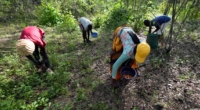Kate Orff’s Living Breakwater project off the shores of Staten Island incorporates various habitats for a biodiverse array of sea life, while also protecting against storm damage. The project is just one example of a new approach to urban design, which incorporates natural systems, and focuses on resilience. Babcock Ranch in Florida is an example of a housing development built with resilience in mind. Kitson and Partners, the firm behind Babcock Ranch, bought the 91,000-acre ranch in 2006 and sold 73,000 acres of it to Florida, which became part of the Florida Wildlife Corridor, while the remaining land was developed with a focus on working with nature rather than against it. Homes and roads were built around the pre-existing natural features of the area, and buildings were constructed to meet Florida Green Building Coalition standards. The development is powered entirely by solar energy, and features a wastewater facility hardened for high wind and underground power lines. Both projects demonstrate the importance of designing for resilience in a changing climate.
Florida’s Vulnerability to Climate Change: Insights from the Aspen Ideas: Climate Conference
Florida, the Sunshine State, with its 825 miles of shoreline and low elevation, is one of the most vulnerable locations for sea-level rise and intensified weather events globally. The state’s susceptibility to climate change became the focus of the second annual Aspen Ideas: Climate conference, where science and design leaders presented some of the most pivotal climate-change questions and potential solutions for Florida.
The four-day conference brought together 300 speakers, including Vice President Kamala Harris, business leaders, conservationists, and journalists, to the Miami Beach Convention Center and the New World Center. It showcased some of the latest advancements in climate research, including wind and wave simulators, concrete hexagonal tubes, and solar housing developments.
Key Takeaways from the Conference
Wind and Wave Simulators
At the University of Miami’s Rosenstiel School of Marine, Atmospheric, and Earth Science SUSTAIN Lab on Virginia Key, Professor Brian K. Haus and his team operate a wind-wave-storm simulator. The simulator creates Category-5 hurricane forces, enabling the team to study the interplay of wind, water, and shoreline.
The simulator has a 25-yard-long pool that is see-through, with a sloping bottom that can be shaped to emulate various shorelines, including Florida’s east and west coasts. The team can create scale models of shoreline and infrastructure and blast it with storm forces to observe surge reactions. They can also determine the protective value of life-size reef or mangrove structures by blasting them with storm forces.
When Haus turned on the wind and waves for Aspen Idea participants visiting the facility, the tank rippled violently with 3-foot waves that would equal 30-foot swells in real life. Haus said one of the most crucial findings has to do with water friction: “Friction from the ocean does not slow down wind as much as previously thought.”
Concrete Hexagonal Tubes
A Miami-based startup called RWDI has developed concrete hexagonal tubes that can potentially save South Florida cities from storm surge. These tubes resemble giant concrete honeycombs, capable of absorbing and deflecting the force of surging water. The tubes are connected to form a barrier that can be adjusted to accommodate varying water levels.
Solar Housing Development
Florida’s vulnerability to hurricanes and other extreme weather events has prompted the development of a solar housing project that can withstand such events without losing power or internet connectivity. The developer, Syd Kitson, created Babcock Ranch, a solar-powered town with energy-efficient housing. The development features a microgrid that can disconnect from the main power grid during an outage to maintain power for essential services.
In conclusion, the Aspen Ideas: Climate conference shed light on some of the latest advancements in climate research and potential solutions for Florida’s vulnerability to climate change. The wind and wave simulators, concrete hexagonal tubes, and solar housing development were some of the most promising innovations presented at the conference.
How Infrastructure Innovation Can Help Florida Survive Climate Change: Insights from the Aspen Ideas: Climate Conference
Florida’s vulnerability to sea-level rise and intensified weather events makes it one of the most vulnerable locations globally. At the second annual Aspen Ideas: Climate conference, science and design leaders discussed potential solutions for Florida’s climate-related challenges. Two panels focused on innovative infrastructure ideas that could help the region, along with other vulnerable areas such as New York, brace for the coming century of climate change.
How Wind and Water Interplay During Storms
At the University of Miami’s Rosenstiel School of Marine, Atmospheric, and Earth Science SUSTAIN Lab, Professor Brian K. Haus and his team operate a wind-wave-storm simulator. The simulator has a 25-yard-long pool that can create Category-5 hurricane forces and lets the team study the interplay of wind, water, and shoreline.
One of the most crucial findings from the simulator is the way wind and water interact. The tank revealed that once wind gets over a certain speed, water drag levels off and stops slowing the storm. The findings have changed hurricane forecast models regarding how quickly hurricanes can build strength and speed.
Coral Reef Futures Lab
Florida’s southeast coast is rimmed by a 350-mile reef that has been damaged by bleaching, a process in which high water temperatures cause corals to expel the symbiotic algae they rely on for photosynthetic nutrition. Coral reefs not only provide vital habitat for hundreds of species of marine life but also help shield civilization from violent hurricane storm surge.
Liv Williamson, senior research associate at the Coral Reef Futures Lab, is attempting to toughen up these beautiful marine organisms by selectively breeding corals to withstand hot water better. The program outplants them on nearby reefs to study their success. Williamson’s program is not only important for nature enthusiasts but also the Department of Defense, which is working with the school to use coral breakwaters around their military installations as a shield against violent storms in the future.
Innovative Infrastructure Ideas
Rodolphe el-Khoury, dean of the University of Miami School of Architecture, stated that design is where the action is, particularly in innovations that combine gray infrastructure and green infrastructure. Landolf Rhode-Barbarigos, assistant professor of architectural engineering at the University of Miami, explained the ECoREEF project he’s working on that combines the two to provide quick protection for humans and benefits to nature.
The project involves providing nature with a platform that dissipates wave energy and provides fertile ground for corals to grow. If successful, it could provide a shield against violent storms while also benefiting marine life.
In conclusion, the Aspen Ideas: Climate conference shed light on potential solutions for Florida’s vulnerability to climate change. Infrastructure innovations that combine gray and green infrastructure and selective breeding of corals to withstand hot water better are among the promising innovations presented at the conference. By adopting these innovative solutions, Florida and other vulnerable areas can prepare for the coming century of climate change.
Building a Living Breakwater to Protect Shorelines and Enhance Biodiversity
Barbarigos, an assistant professor of architectural engineering at the University of Miami, has developed concrete hexagonal tubes that cities can place offshore. The design allows the structures to break up wave energy and storm surge, while also providing a surface for coral to attach and thrive. The hexagons are 19 feet long and 6 feet tall and can become a living breakwater by transplanting corals and monitoring the ecological growth and engineering performance.
To test the effectiveness of these hexagonal tubes, Barbarigos and his team installed a set of the structures off Surfside recently. The surfaces will be covered with live corals that can grow four inches a year, essentially becoming a living breakwater that will grow over time to protect shorelines more rigorously. Additionally, the structures will attract food chains of sea life to the shoreline.
Living Breakwaters for New York City
After Hurricane Sandy in 2012, New York City tasked designer Kate Orff, founding principal and partner at SCAPE, a landscape architecture and urban design practice, with protecting the city with a living breakwater. Orff and her team created the Living Breakwaters, a 1.5-mile necklace of living breakwaters off the coast of Staten Island. The breakwaters reduce risk, help rebuild the shoreline, and stop the collapse of marine life by creating pockets, such as tidal pools, and graduated water depths to enhance biodiversity.
The breakwaters, which are designed for sea life, are seeded with oysters that filter the water. On Orff’s project and others around the city, oyster populations blossomed, making the water clearer. Baitfish, predatory fish, and dolphins have returned to New York Harbor, and even whales have shown up.
Orff believes that the most resilience will come from a robust, living, three-dimensional landscape. She warns against a vertical bulkhead seawall that is easy and fast to build but may cause the loss of intertidal habitat, fish nurseries, seagrass, and reefs. Her efforts aim to build a bridge so that life on earth can sustain itself, and we can hold on, too.
In conclusion, these innovative living breakwaters, which can be designed for sea life and enhance biodiversity, are promising solutions to protect shorelines against storm surges and reduce the risk of future natural disasters. By investing in these living landscapes, we can build resilience and enhance the environment while providing protection for vulnerable communities.
Solar-Powered Development Survives Hurricane Ian
Babcock Ranch, a new housing development located just east of Fort Myers, was battered by Hurricane Ian for eight hours, with sustained winds of 100 mph and gusts up to 150 mph. Despite the ferocity of the hurricane, the development never lost power, water, or internet. This is because Babcock Ranch was designed to be resilient, with a 150-megawatt solar facility featuring 700,000 panels providing all the necessary power. Babcock Ranch CEO Kitson & Partners, the firm that planned the development, says their goal was to prove that a new town and the environment can work hand-in-hand. Half of the development’s 18,000 acres are preserved, meaning 90% of the original land is protected in some way. The project’s success highlights the importance of green infrastructure and how it can help protect communities in the face of natural disasters.
Behavioral and Policy Changes Are Key to Long-Term Success
Although projects like Babcock Ranch and the Living Breakwaters off the coast of Staten Island demonstrate the potential of green infrastructure, they alone are insufficient. Kate Orff, the designer behind the Living Breakwaters project, believes that the most challenging changes are behavioral and policy changes at federal, state, and local levels. Orff believes that we need to have incredibly difficult conversations about what we need to stop doing if we are to succeed. She points to the seagrass die-off in Biscayne Bay and states that until we reduce nutrient load, which prompts die-offs, we cannot succeed. The coming months will determine what happens with the Army Corps of Engineers’ proposed monolithic seawall, which the community has rejected in favor of a combination of gray and green infrastructure.
Coral Breakwaters Can Help Protect Shorelines
The University of Miami’s ECoREEF program selectively breeds corals to withstand hot water better and outplants them on nearby reefs to study their success. The goal is to help protect the 350-mile reef off Florida’s southeast coast, which has been damaged by bleaching, a process in which high water temperatures cause the corals to expel the symbiotic algae they rely on for photosynthetic nutrition. Coral reefs not only provide vital habitat for hundreds of species of marine life but also help shield civilization from violent hurricane storm surges. To give natural reefs a head start, Rodolphe el-Khoury, dean of the University of Miami School of Architecture, developed concrete hexagonal tubes that cities can place offshore. The design allows them to break up wave energy and storm surge, but they’re made of a material and texture where coral can be attached and thrive.
Conclusion
These projects demonstrate the importance of developing infrastructure that is resilient in the face of natural disasters. Green infrastructure like coral breakwaters and living breakwaters can help protect shorelines while also promoting biodiversity. Projects like Babcock Ranch, which was designed to be powered entirely by solar, highlight the importance of sustainable development in a changing climate. However, long-term success will require difficult conversations about behavioral and policy changes at all levels of government.
Babcock Ranch’s ability to withstand Hurricane Ian began with the location choice, as it is 30 feet above storm surge level. The architects studied the historic water flow in the area and mimicked the drainage system to help absorb surface water and prevent flooding. The community was built around the pre-existing natural landscape, which includes space for wetlands throughout the community. Babcock Ranch has a wastewater facility designed to withstand high wind, and underground power lines. All buildings in the community meet Florida Green Building Coalition standards. The firm’s approach to developing land is to work with nature, rather than against it. The community is an investment that is nominal in comparison to the potential losses of property, productivity, and life. New technology is expected to make the world a safer place, and this is good news for future generations.
Don’t miss interesting posts on Famousbio










